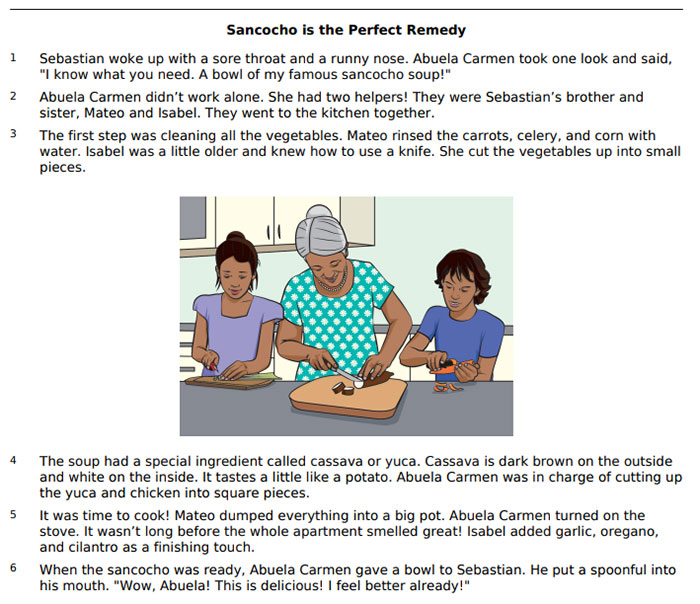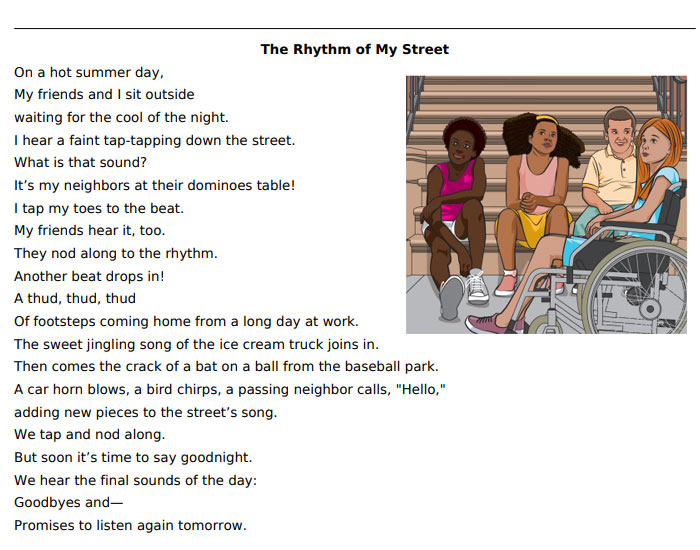September 28, 2023
As the new school year kicks into full swing around the country, Renaissance’s commitment to “See Every Student” is more relevant than ever. Educators need digital tools that offer detailed insight into their students’ strengths and needs, allowing them to deliver effective personalized instruction. This is how we accelerate learning for all students.
The importance of seeing every student is also applicable to the content in Renaissance products. More specifically, our content teams make a concerted effort to ensure that every student feels seen when they interact with our products. Our goal is to produce content that truly reflects students’ multiple and intersecting identities.
Why is this so essential?
Offering students this “mirror” in which they can see themselves uplifted in the material affirms their culture and contributes to a sense of belonging in the classroom and in society (Bishop, 1990). Likewise, providing students with a “window” to learn about others’ stories, traditions, and practices allows students to explore their place in a multicultural and pluralistic world (Tschida, Ryan, & Ticknor, 2014). By producing culturally inclusive content, Renaissance products reflect our diverse society and celebrate both our uniqueness and our commonalities.
The importance of relevant and personally meaningful educational content is not a new concept. In a previous Renaissance blog, we addressed the impact and application of culturally relevant pedagogy in today’s classrooms. We also explored how the Accelerated Reader team prioritizes diverse representation in the books chosen for quizzing, and how the Star Assessments content team creates assessment items that are not biased against particular groups of people.
In this blog, we’ll spotlight two of the more recent additions to the Renaissance family—DnA and SchoolCity—and their unique approach to delivering culturally relevant assessments.

How customizable technology allows for inclusive and relevant assessment
Perhaps the most impactful feature that allows DnA and SchoolCity assessments to deliver culturally relevant content is their customizable nature. While both offer pre-built assessments aligned to state standards, educators may also build their own assessments using more than 80,000 high-quality, standards-aligned items across English Language Arts, math, science, and history.
The items include traditional item types, such as multiple choice and constructed response, as well as technology-enhanced multiple response and evidence-based selected response (EBSR) items. In addition, the large, customizable passage bank with a variety of item types allows the DnA and SchoolCity content teams—known internally as the Inspect team—to develop content exploring a wide range of topics that represent diverse populations.
As a result, teachers, school leaders, and district administrators can choose the items and question types that best meet students’ needs, including passages featuring content most relevant to their communities. By allowing this level of customization, DnA and SchoolCity assessments offer the unique ability to balance both culturally relevant assessment content and large-scale administration.

Prioritizing diversity and inclusion in assessment content
The Inspect team understands that developing truly representative content requires ongoing measurement and analysis. Therefore, team members have begun monitoring diversity in content by analyzing the representation of different:
- Racial groups
- Geographic regions
- Religions
- Physical abilities
- Neurodiversities
- Roles and careers
The team compares this data to national demographics as a measure of how well the content reflects the student population. If the audit reveals uneven or disproportionate representation, the Inspect team makes the appropriate adjustments during their annual goal-setting process.
Every year, the Inspect team determines the number of passages that will be added to the passage bank. Fifty percent of passages are literary text—such as stories, dramas, and poetry—that examine and normalize diversity through characters, situations, and language. The other half are informational texts that explore events, people, and popular culture.
All genres provide examples of people in non-traditional roles, multigenerational familial and neighborhood relationships, and those who have been trailblazers. The goal is to ensure all students can see their histories and their potential futures reflected in the passages throughout DnA and SchoolCity assessments.

Focusing on quantity and quality of representation in assessment
Of course, it’s not sufficient to focus only on quantity when it comes to representation; we must ensure the quality of representation as well. All content—especially content about historically marginalized groups—should be accurate, age-appropriate, and respectful. Students should feel uplifted and empowered when they see their cultures reflected in our assessment content and should believe the material is an accurate representation of their collective stories.
Let’s consider two examples to help illustrate these points.
Example #1: Centering lived experiences in assessment
Consider how the literary passage below centers the lived experiences of a Latino family. The passage, which is intended to be read aloud to kindergarten students, and the questions that follow (which we have omitted to limit item exposure) assess students’ understanding of the characters, setting, events, and vocabulary presented in the passage.
The story describes a family preparing soup for someone who feels unwell, a scenario that many children will find relatable. The soup, however, is not the chicken noodle soup popular in many US households, but rather sancocho, a Latin American dish made with a variety of meats and root vegetables:

Note that the story does not indicate the family’s ethnic background or explain the extended family structure, which is common in families of color. Allowing such characteristics to exist without explicitly mentioning them is how the Inspect team normalizes diverse lived experiences.
Another important note about this passage is that, although it centers a specific ethnic background, it is still accessible to people of other cultures. Students are provided with translations and descriptions for words in Spanish (e.g., yuca is cassava, which tastes a little like a potato) or given context clues in the text and in the picture (e.g., abuela is the title of the adult caring for them).
One does not need to be familiar with yuca or know the direct translation of abuela to comprehend the passage and respond to the questions accurately. This is what makes DnA and SchoolCity assessments both culturally enriching and bias-free.
Example #2: Increasing diversity of representation in assessment
Increasing the diversity of representation in assessment content does not only consider race and ethnicity, nor does it focus only on food. Rather, Renaissance content teams explore different identities salient to school-aged students and include these identities in the content.
Consider the poem below, which is also intended to be read aloud to kindergarten students and assess their comprehension of the setting, events, and vocabulary. The passage celebrates a summer day in an urban neighborhood and shows a diverse group of friends sitting on or near the stoop of a building:

Without speaking to any specific geographic location, economic status, disability, or race/ethnicity, the poem describes and depicts a neighborhood that will resonate with many students globally, whether they live in a city or not.
How Renaissance develops culturally relevant assessment content
While the Inspect team is composed of content experts with an understanding of what makes content grade- and age-level appropriate for students across the K–12 spectrum, they have also embarked on a multi-year effort to become better versed in developing culturally relevant content. The team, which is made up of former educators, content writers, and copy editors, regularly consults with external parties to ensure content is a respectful and appropriate representation of students’ beliefs and lived experiences.
For instance, the team recently consulted with the Renaissance Content Quality Advisory Committee, an advisory board composed of external professionals with expertise in content development and matters related to diversity, equity, and inclusion (DEI). The Content Quality Advisory Committee reviewed dozens of DnA and SchoolCity passages and engaged the Inspect team in a discussion of cultural inclusion in content.
One topic raised during the discussion included best practices for acknowledging the realities some students face in a manner that is not disempowering. For example, when representing Native American populations, the Inspect team takes precautions to avoid using:
- Defeatist language
- Language that portrays them as a single group
- Language that portrays them as a population that existed in historical times only
A second example: When ensuring that students from economically disadvantaged neighborhoods are reflected in content, the team focuses on the characters’ assets (e.g., friendships) and not deficits.
These discussions occur often, both formally and informally, and key points from the discussions are considered in the detailed specifications for a passage, in any feedback provided on the pitch from the content writer, and in the final draft. By keeping inclusion in mind throughout the entire content development process, the Inspect team produces appropriate and inclusive content that represents a wide range of experiences.

Conclusion: The benefits of diverse and inclusive assessment content
The benefits of culturally relevant content in the classroom have long been documented, but its application to assessments is still relatively recent. Fears of biasing one group over another have led many to attempt to remove any instance of culture from assessments. As we discussed in a previous blog, this practice doesn’t remove culture; it only centers mainstream culture.
Research shows that when students connect with the content, they are more engaged, are better able to demonstrate mastery, and experience an increased sense of belonging (Howard, 2001; Renninger, Ewen, & Lasher, 2002). Therefore, it is a matter of educational equity that assessments consider and reflect the lived experiences of all students, not just the largest group (Montenegro & Jankowski, 2017). And both DnA and SchoolCity offer a unique approach to delivering assessments that are both relevant and bias-free.
Across Renaissance, we believe that students deserve to feel that their stories are valued. Our teams have embarked on a multi-year journey to implement systems and best practices for producing content that accurately and appropriately reflects the students and communities we serve. By celebrating diversity and acknowledging our commonalities, the content in Renaissance products seeks to ensure that every student feels seen.
Learn more
Connect with an expert to learn more about DnA and SchoolCity for standards-based, inclusive assessment from kindergarten through grade 12.
References
Bishop, R. S. (1990). Windows and mirrors: Children’s books and parallel cultures. In California State University reading conference: 14th annual conference proceedings (pp. 3–12).
Howard, T. (2001). Telling their side of the story: African American students’ perceptions of culturally relevant teaching. The Urban Review, 33(2), 131–149.
Montenegro, E., & Jankowski, N. A. (2017). Equity and assessment: Moving towards culturally responsive assessment. (Occasional Paper No. 29). Urbana, IL: University of Illinois and Indiana University, National Institute for Learning Outcomes Assessment (NILOA).
Renninger, K., Ewen, L., & Lasher, A. (2002). Individual interest as context in expository text and mathematical word problems. Learning and Instruction, 12, 467–491.
Tschida, C. M., Ryan, C. L., & Ticknor, A. S. (2014). Building on windows and mirrors: Encouraging the disruption of “single stories” through children’s literature. Journal of Children’s Literature, 40(1), 28–39.

